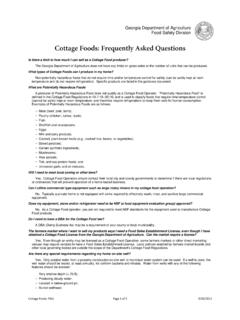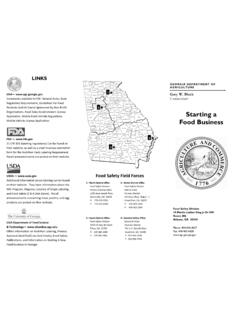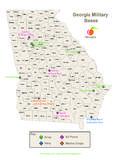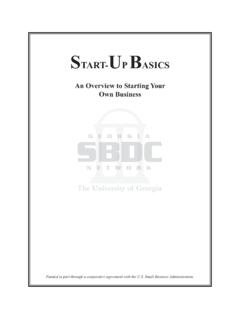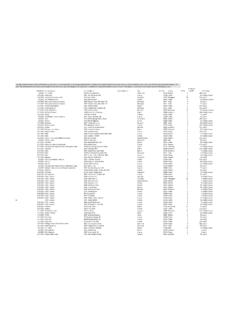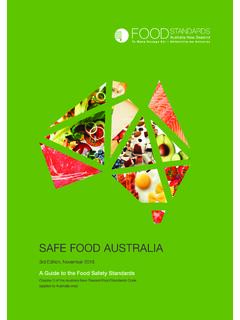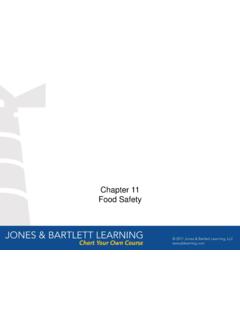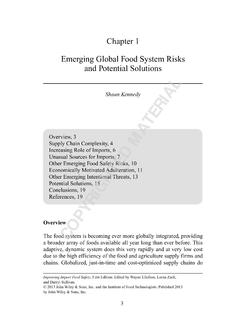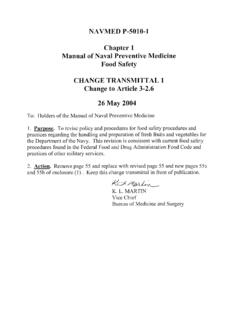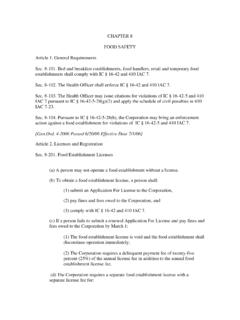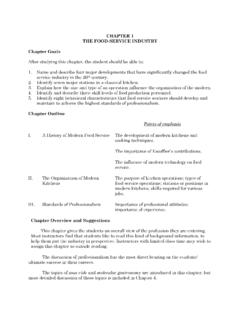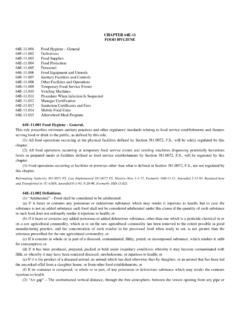Transcription of RULES OF GEORGIA DEPARTMENT OF AGRICULTURE FOOD …
1 Additional Regulations Applicable chapter 40-7-18 To Processing Plants 1 RULES OF GEORGIA DEPARTMENT OF AGRICULTURE food safety DIVISION chapter 40-7-18 ADDITIONAL REGULATIONS APPLICABLE TO PROCESSING PLANTS TABLE OF CONTENTS Scope of Regulations Records Definitions Written food safety Plan Right of Entry Exemption Preventing food and Ingredient Contamination Trade Secrets Laboratory Requirements Adoption of Reference Testing Civil Penalties Reporting License to Operate Scope of Regulations. The following regulations shall apply to all plants where food is PROCESSED, which are not covered elsewhere in these regulations. Definitions. The following definitions shall apply in the interpretation and enforcement of this chapter . (1) Act means The GEORGIA food Act. (2) Adulterated as defined in GEORGIA food Act Section 26-2-26. (3) "Balut" means an embryo inside a fertile EGG that has been incubated for a period sufficient for the embryo to reach a specific stage of development after which it is removed from incubation before hatching.
2 (4) Code of Federal Regulations means the compilation of the general and permanent RULES published in the Federal Register by the executive departments and agencies of the federal government. (5) Commissioner means Commissioner of AGRICULTURE of the State of GEORGIA . (6) Consumer means a PERSON who is a member of the public, takes possession of food , is not functioning in the capacity of an operator of a food establishment or food PROCESSING PLANT, and does not offer the food for resale. (7) Critical Control Point means a point or procedure in a specific food system where loss of control may result in an unacceptable health RISK. Additional Regulations Applicable chapter 40-7-18 To Processing Plants 2 (8) Critical Limit means the maximum or minimum value to which a physical, biological, or chemical parameter must be controlled at a CRITICAL CONTROL POINT to minimize the RISK that the identified food safety HAZARD may occur. (9) DEPARTMENT means the GEORGIA DEPARTMENT of AGRICULTURE .
3 (10) DEPARTMENT Representative means any officer, inspector, agent or employee of the GEORGIA DEPARTMENT of AGRICULTURE who is authorized by the COMMISSIONER with the duty of enforcing these regulations. (11) Egg means the shell egg of avian species such as chicken, duck, goose, guinea, quail, RATITES or turkey. egg does not include: (a) a BALUT; (b) the egg of reptile species such as alligator; or (c) an EGG PRODUCT. (12) Egg Product means all, or a portion of, the contents found inside EGGS separated from the shell and pasteurized in a food PROCESSING PLANT, with or without added ingredients, intended for human consumption, such as dried, frozen or liquid EGGS. Egg product does not include food which contains EGGS only in a relatively small proportion such as cake mixes. (13) Employee means the License Holder, PERSON IN CHARGE, food EMPLOYEE, PERSON having supervisory or management duties, PERSON on the payroll, family member, volunteer, PERSON performing work under contractual agreement, or other PERSON working in a food PROCESSING PLANT.
4 (14) Exemption means a written document issued by the REGULATORY AUTHORITY that authorizes a modification or waiver of one or more requirements of this Code if, in the opinion of the REGULATORY AUTHORITY, a health HAZARD or nuisance will not result from the modification or waiver. (15) food means a raw, cooked, or PROCESSED edible substance, ice, beverage, or ingredient used or intended for use or for sale in whole or in part for human consumption, or chewing gum. (16) " food Employee" means an individual working with unpackaged food , food equipment or utensils, or food -contact surfaces. (17) food Processing Plant means a commercial operation that manufactures food for human consumption and does not provide food directly to a CONSUMER from that location. Such term shall not include a commercial operation that produces raw agricultural commodities and whose end product remains a RAW AGRICULTURAL PRODUCT. (18) HACCP Plan means a written document that delineates the formal procedures for following the Hazard Analysis and CRITICAL CONTROL POINT (HACCP) principals developed by the National Advisory Committee on Microbiological Criteria for Foods.
5 Additional Regulations Applicable chapter 40-7-18 To Processing Plants 3 (19) Hazard means a biological, chemical, or physical property that is likely to cause an unacceptable CONSUMER health RISK. (20) Hermetically Sealed Container means a container which is designed and intended to secure against entry of microorganisms and, in the case of low acid canned FOODS, to maintain the commercial sterility of its contents after PROCESSING. (21) High Risk Facility means a facility which produces a HIGH RISK PRODUCT or a lower-RISK product distributed to HIGHLY SUSCEPTIBLE POPULATIONS or in such volume that a violative product poses a significant threat to public health. (22) High Risk Product means a product, which has been classified by the classification committee appointed by the COMMISSIONER, to carry a high potential for contamination or foodborne illness. (23) "Highly Susceptible Population" means PERSONS who are more likely than other people in the general population to experience foodborne disease because they are: (a) Immunocompromised; preschool age children, or older adults; and (b) Obtaining food at a facility that provides services such as custodial care, health care, or assisted living, such as a child or adult day care center, kidney dialysis center, hospital or nursing home, or nutritional or socialization services such as a senior center.
6 (24) "Imminent Health Hazard" means a significant threat or danger to health that is considered to exist when there is evidence sufficient to show that a product, practice, circumstance, or event creates a situation that requires immediate correction or cessation of operation to prevent injury based on: (a) The number of potential injuries, and (b) The nature, severity, and duration of the anticipated injury. (25) License means the document issued by the DEPARTMENT , which authorizes a PERSON to operate a food PROCESSING PLANT. (26) Low Risk Facility means a firm which produces or stores a low-RISK product and whose target population or distribution does not increase the potential public health threat of a violative product. (27) Low Risk Product means a product that has been classified by the classification committee appointed by the COMMISSIONER, which carries a low potential for contamination or foodborne illness. (28) Moderate Risk Facility means a firm which produces a MODERATE RISK PRODUCT or which produces a lower-RISK product distributed to HIGHLY SUSCEPTIBLE POPULATIONS or in such volume that a violative product poses a moderate threat to public health.
7 (29) Moderate Risk Product means a product that has been classified by the classification committee appointed by the COMMISSIONER, which carries a moderate potential for contamination or foodborne illness. (30) Person means an association, a corporation, individual, partnership, other legal entity, government, or governmental subdivision or agency. Additional Regulations Applicable chapter 40-7-18 To Processing Plants 4 (31) "Person In Charge" means the individual present at a food PROCESSING PLANT who is responsible for the operation at the time of inspection. (32) pH means the symbol for the negative logarithm of the hydrogen ion concentration, which is a measure of the degree of acidity or alkalinity of a solution. (33) Poisonous or Deleterious Substances means substances that are not intended for ingestion. (34) Potentially Hazardous food (Time/Temperature Control for safety food ). (a) "Potentially hazardous food (time/temperature control for safety food )" means a food that requires time/temperature control for safety (TCS) to limit pathogenic microorganism growth or toxin formation.
8 (b) "Potentially hazardous food (time/temperature control for safety food )" includes: 1. An animal food that is raw or heat-treated; a plant food that is heat-treated or consists of raw seed sprouts, cut melons, cut tomatoes or mixtures of cut tomatoes that are not modified in a way so that they are unable to support pathogenic microorganism growth or toxin formation, or garlic-in-oil mixtures that are not modified in a way so that they are unable to support pathogenic microorganism growth or toxin formation; and 2. Except as specified in Subparagraph (3)(d) of this definition, a food that because of the interaction of its Aw and pH values is designated as Product Assessment Required (PA) in Table A or B of this definition: Additional Regulations Applicable chapter 40-7-18 To Processing Plants 5 (c) "Potentially hazardous food (time/temperature control for safety food )" does not include: 1. An air-cooled hard-boiled EGG with shell intact, or an EGG with shell intact that is not hard-boiled, but has been pasteurized to destroy all viable salmonellae; 2.
9 A food in an unopened HERMETICALLY SEALED CONTAINER that is commercially PROCESSED to achieve and maintain commercial sterility under conditions of non-refrigerated storage and distribution; 3. A food that because of its pH or Aw value, or interaction of Aw and pH values, is designated as a non-PHF/non-TCS food in Table A or B of this definition; 4. A food that is designated as Product Assessment Required (PA) in Table A or B of this definition and has undergone a Product Assessment showing that the growth or toxin formation of pathogenic microorganisms that are reasonably likely to occur in that food is precluded due to: (i) Intrinsic factors including added or natural characteristics of the food such as preservatives, antimicrobials, humectants, acidulants, or nutrients; (ii) Extrinsic factors including environmental or operational factors that affect the food such as packaging, modified atmosphere such as REDUCED OXYGEN PACKAGING, shelf life and use, or temperature range of storage and use; Additional Regulations Applicable chapter 40-7-18 To Processing Plants 6 (iii) A combination of intrinsic and extrinsic factors; or 5.
10 A food that does not support the growth or toxin formation of pathogenic microorganisms in accordance with one of the Subparagraphs (3)(a) - (3)(d) of this definition even though the food may contain a pathogenic microorganism or chemical or physical contaminant at a level sufficient to cause illness or injury. (35) Processing or Process means any or all of the physical and/or chemical alterations applied to a food ; as it is taken from its original state; or any food which has been partially or fully processed previously; and either prepared further by cooking or made into another form before being marketed. (36) "Ratite" means a flightless bird such as an emu, ostrich, or rhea. (37) Raw Agricultural Product means any agricultural commodity in its raw or natural state that has undergone little or no PROCESSING. This product would require further PROCESSING before consumption. (38) Ready-to-Eat food means food that is in a form that is edible without washing, cooking, or additional preparation by the food establishment or CONSUMER and that is reasonably expected to be consumed in that form.
